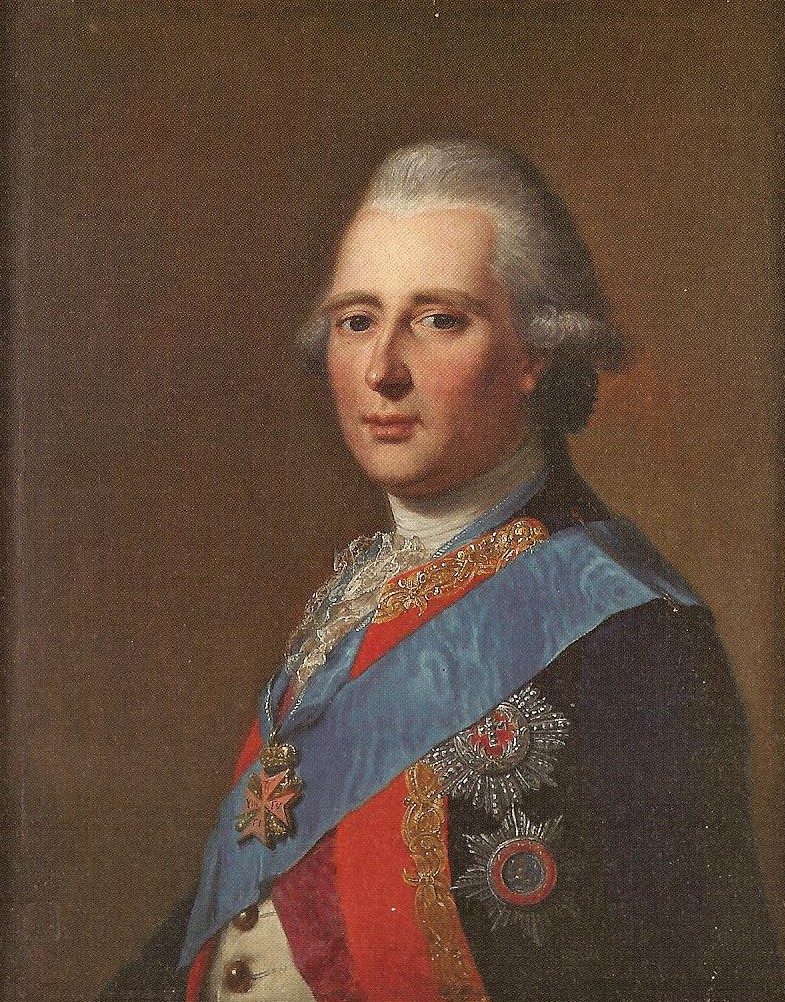by Susan Flantzer © Unofficial Royalty 2019

Friedrich II, Landgrave of Hesse-Kassel; Credit – Wikipedia
Friedrich II, Landgrave of Hesse-Kassel was the husband of Princess Mary of Great Britain, daughter of King George II of Great Britain. He became famous during the American Revolution as a supplier of thousands of Hessian soldiers who fought on behalf of the British.
Born on August 14, 1720, in Kassel in the Landgraviate of Hesse-Kassel, now in Hesse, Germany, Friedrich was the eldest surviving son of Wilhelm VIII, Landgrave of Hesse-Kassel and his wife Dorothea Wilhelmine of Saxe-Zeitz. His paternal uncle was King Fredrik I of Sweden.
Friedrich had two siblings:
- Prince Karl of Hesse-Kassel (1718 – 1719), died in infancy
- Princess Maria Amalia of Hesse-Kassel (1721 – 1744), died while engaged to be married to Margrave Karl Friedrich Albrecht of Brandenburg-Schwedt
In 1725, when Friedrich was five years old, his mother became mentally ill and never again appeared at court. Friedrich was first educated by Colonel August Moritz von Donop and then by the Swiss theologian and philosopher Jean-Pierre de Crousaz.

Princess Mary of Great Britain, Friedrich’s first wife; Credit – By Johann Heinrich Tischbein – Museumslandschaft Hessen Kassel, CC BY-SA 4.0, https://commons.wikimedia.org/w/index.php?curid=74554565
In 1740, a marriage was arranged for the 20-year-old Friedrich with 17-year-old Princess Mary of Great Britain, a daughter of King George II of Great Britain and his wife Caroline of Ansbach. A proxy marriage, with Mary’s brother Prince William, Duke of Cumberland standing in for the groom, was held on May 19, 1740, in the Chapel Royal of St. James’ Palace in London, England. Mary left England in June and married Friedrich in person on June 28, 1740.
Mary and Friedrich had four sons:
- Prince Wilhelm of Hesse-Kassel (1741 – 1742), died in infancy
- Wilhelm I, Prince-Elector of Hesse (1743 – 1821), married his first cousin Wilhelmina Caroline of Denmark and Norway, daughter of his maternal aunt Louisa of Great Britain and King Friedrich V of Denmark, had two sons and two daughters
- Prince Karl of Hesse-Kassel (1744 – 1836), married his first cousin Louise of Denmark and Norway, daughter of his maternal aunt Louisa of Great Britain and King Friedrich V of Denmark, had three sons and three daughters including Marie who married King Frederik VI of Denmark
- Prince Friedrich of Hesse-Kassel (1747 – 1837), married Caroline of Nassau-Usingen, had five sons and three daughters including Augusta who married Prince Adolphus, Duke of Cambridge, son of King George III of the United Kingdom



Friedrich and Mary’s sons: Wilhelm, Karl, and Friedrich; Credit – Wikipedia
Friedrich and his wife Mary are ancestors of the current British royal family through their fourth son Prince Friedrich. Prince Friedrich’s daughter Augusta was the grandmother of Princess Victoria Mary of Teck, better known as Queen Mary, the wife of King George V of the United Kingdom. Through their third son Prince Karl, Friedrich and Mary are great-grandparents of King Christian IX of Denmark. Through King Christian IX, Friedrich and Mary are ancestors of six of the ten current European royal families: Belgium, Denmark, Luxembourg, Norway, Spain, and the United Kingdom.
Friedrich and Mary’s marriage was not happy and Friedrich was cruel and abusive. After the birth of their fourth son, Friedrich left Mary and their sons. Eventually, Friedrich sent her a letter saying that before they had married, he had been in love with a Catholic woman he had wanted to marry. However, she would not agree to marry Friedrich unless he converted to Catholicism which he refused to do, fearing the reaction of his family and future subjects. Shortly before the birth of his fourth son, Friedrich received word that his former love was dying and he went to see her. She asked him to convert to Catholicism so their souls could be reunited in heaven and Friedrich agreed to do so. In February 1749, Friedrich visited the Archbishop-Elector of Cologne Clemens August of Bavaria who received him into the Roman Catholic Church. Furious, Mary’s father King George II ordered his daughter back to England but she refused, saying that it was her duty to remain in the place that God had placed her and that she would ensure her sons would be brought up Protestant.
By 1754, it became obvious to Friedrich’s father Wilhelm VIII, Landgrave of Hesse-Kassel, that the marriage of his son and Mary was irretrievably broken and he agreed that his daughter-in-law and grandchildren should live with him. In 1755, Mary and Friedrich officially separated but Mary refused a divorce to deprive her husband of the opportunity to remarry. Friedrich’s father ordered him to leave the Protestant religion untouched in Hesse-Kassel and gave his eldest grandson the County of Hanau-Münzenberg, under the regency of Mary. Friedrich never saw his wife again and did not see his children until 1782.

Friedrich’s second wife Philippine of Brandenburg-Schwedt; Credit – Wikipedia
In 1760, Wilhelm VIII, Landgrave of Hesse-Kassel died and Friedrich became Landgrave of Hesse-Kassel. As there had been no divorce, Mary was then Landgravine of Hesse-Kassel. When Mary died in 1772, Friedrich was finally free to marry again. On January 10, 1773, Friedrich married Margravine Philippine of Brandenburg-Schwedt, who was twenty-five years younger than her husband. Philippine was the daughter of Margrave Friedrich Wilhelm of Brandenburg-Schwedt and his wife Princess Sophia Dorothea of Prussia. Wilhelm and Philippine had no children but eventually, Philippine reconciled her husband with his children from his first marriage, from whom he had been estranged since 1754.

Hessian soldiers; Credit – Wikipedia
At that time, it was the usual practice for smaller principalities to rent out their soldiers to other countries, and Friedrich was no exception. He rented out so many soldiers to his first wife’s nephew King George III of Great Britain for use during the American Revolution, that “Hessian” became an American term for all German soldiers used by the British during the American Revolution. With the income received from hiring out his soldiers, Friedrich became one of the richest rulers in Germany. With this revenue, he became a patron of the arts and sciences and hired architect Simon Louis du Ry to transform the town of Kassel into a modern capital city.
On October 31, 1785, Friedrich II, Landgrave of Hesse-Kassel died suddenly from a stroke at the age of 65 at Castle Wessenstein (now known as Castle Wilhelmshöhe) in Kassel in the Landgraviate of Hesse-Kassel, now in Hesse, Germany. He left behind a developed economy and a full treasury for his son and successor, Wilhelm IX, Landgrave of Hesse-Kassel. Friedrich was buried at the Roman Catholic Church of St. Elisabeth (link in German) in Kassel which was built on Friedrich’s order by architect Simon Louis du Ry between 1770 and 1777. The original church was destroyed during World War II and rebuilt after the war. Friedrich’s remains were reinterred in the new church in a new tomb. He is the only Landgrave of Hesse-Kassel not buried in the Protestant Martinskirche (St. Martin’s Church) (link in German) in Kassel.

Tomb of Friedrich II, Landgrave of Hesse-Kassel; Credit – By FriedrichII-hessen-kassel-grab-elisabethkirche.jpg: ChristosVderivative work: Rabanus Flavus – This file was derived from: FriedrichII-hessen-kassel-grab-elisabethkirche.jpg:, CC BY-SA 3.0, https://commons.wikimedia.org/w/index.php?curid=23414512
This article is the intellectual property of Unofficial Royalty and is NOT TO BE COPIED, EDITED, OR POSTED IN ANY FORM ON ANOTHER WEBSITE under any circumstances. It is permissible to use a link that directs to Unofficial Royalty.
Works Cited
- De.wikipedia.org. (2019). Friedrich II. (Hessen-Kassel). [online] Available at: https://de.wikipedia.org/wiki/Friedrich_II._(Hessen-Kassel) [Accessed 17 Jul. 2019].
- En.wikipedia.org. (2019). Frederick II, Landgrave of Hesse-Kassel. [online] Available at: https://en.wikipedia.org/wiki/Frederick_II,_Landgrave_of_Hesse-Kassel [Accessed 17 Jul. 2019].
- Flantzer, S. (2019). Princess Mary of Great Britain, Landgravine of Hesse-Kassel. [online] Unofficial Royalty. Available at: https://www.unofficialroyalty.com/princess-mary-of-great-britain-landgravine-of-hesse-kassel/ [Accessed 17 Jul. 2019].
- Ru.wikipedia.org. (2019). Фридрих II (ландграф Гессен-Касселя). [online] Available at: https://ru.wikipedia.org/wiki/%D0%A4%D1%80%D0%B8%D0%B4%D1%80%D0%B8%D1%85_II_(%D0%BB%D0%B0%D0%BD%D0%B4%D0%B3%D1%80%D0%B0%D1%84_%D0%93%D0%B5%D1%81%D1%81%D0%B5%D0%BD-%D0%9A%D0%B0%D1%81%D1%81%D0%B5%D0%BB%D1%8F) [Accessed 17 Jul. 2019].
- Van der Kiste, J. (2013). King George II and Queen Caroline. New York: The History Press.
Van Der Kiste, John. The Georgian Princesses. Phoenix Mill: Sutton Publishing, 2000. Print.
Williamson, David. Brewer’s British Royalty. London: Cassell, 1996. Print. London: Cassell, 1996. Print.
